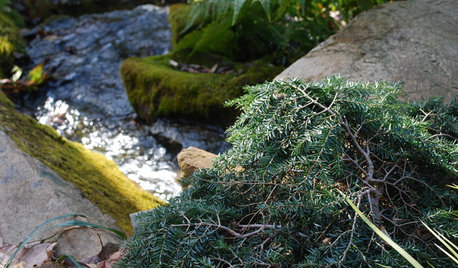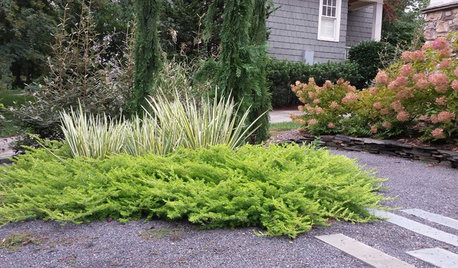'How To Graft'
Feb. 12, 2007
Grafting:
Conifers:
Tools:
A very sharp knife
Parafilm Tape
Budding strips, rubber bands (either or) I use 5" in length and about " across
Rubbing Alcohol to keep the blade free of sap or of spreading disease
Optional, I use a cutting board for kitchen use. A bench to work at or picnic table, etc Â
Possibly a pair of hand pruners
I keep a pair of tiny scissors around and a pair of all-purpose scissors around
I keep an exacto knife around, the small kind with the pen-like shaft
Bottom Heat (70 is fine, plus or minus a few degrees)
Tented Box  clear poly box to keep humidity up.
Three Basic Elements For Success:
Water  donÂt over water, donÂt underwater
Humidity  keep air humid  will discuss*
Temperature  anywhere in the 45-55 degree range is ideal but IÂll discuss this further as well.
Physical Work:
*Usually seedlings are purchased in winter for spring delivery. IÂve come to find that I prefer plugs over bareroot. Seedlings are potted immediately upon arrival and the choice of container to pot in is entirely up to the grafter. I use ÂAnderson Tree Bands which can be purchased in cases only, 200 per case from OBC Northwest online. They have a telephone # that must be called to place an order. I also buy my rooting hormone from these folks. A 1# bag of Hormex #8 wholesale is about 30 bucks I think. There are three sizes of Tree Bands Anderson makes, I buy for all purpose the 5" pot. IÂd recommend at least that size and at times, a larger size is needed. Very often does a seedling need a smaller pot than the 5" and for that, you can simply use a 4" nursery pot. Some growers actually use a 4" "rose pot" for all their spring potting up. Like I say, itÂs your call. The Tree band style pot is nice because it is ergonomically designed to force the roots downward and the roots to be air-pruned at the bottom if the pot is elevated off the ground. For this, I use nursery flats with drainage.
At this time of potting-up, remove all but a few branches or leave it as is until come winter. At either point in time youÂll be removing side branches or whatever you choose to keep on the seedling so that when time comes to graft to this seedling, youÂll have plenty of room, "workspace" for the job to occur.
These seedlings are now venerable to being sun-scorched and killed. This is very important to know. A large deciduous tree or a large conifer is perfect for the *entire first yearÂs care of each seedling. You want to keep them in dappled sunlight or late afternoon sun having been shaded all day prior. I hope that last sentence makes sense.
Again, water as necessary.
Anytime from December 1st through January 1st, you need to bring the potted seedlings (your understocks to graft onto into the greenhouse or man-made indoor structure  which IÂll discuss later).
Since I donÂt currently graft very much (200 plants maximum) I choose to bring my understocks in as late as possible so I can save money on the cost to heat my greenhouse/prophouse. After the plants have been brought in, it takes anywhere from 2-4 weeks typically for them to "spring" back into life (begin growing)ÂThis is called "push" or "pushing", "breaking bud", or probably many other terms given to describe this time. You may only begin to graft when at least "2/3" of your understocks being pushing and/or when 2/3 of the plants show white-tips on the roots flaring from the bottom of the containers.
Your understocks will be sorted into blocks generally. I happen to know the difference between each of mine so I arrange them according to height. If you arenÂt comfortable doing this, keep them sorted in blocks. At this point your (heat mats, bottom heat system) is running and so is everything else. I also use an item called a cool puff mister that you can buy at a WalgreenÂs or any drug store, or wherever. This keeps water droplets in the air and helps to cool the house as well as an aid to increasing humidity.
Before I go any farther, IÂm going to explain an indoor set-up. This could be done in a garage, a basement, your barn, in your buddies garage, his basement, wherever you choose. This is very simple. Earlier I explained the three elements necessary for success. If you can accomplish all three of those indoor, youÂre good to go. This is the point that everybody misses: You need to replicate mother nature "indoors" as she is "outdoors." That means the lighting system you use, needs to replicate the hours of sun being observed outdoors. If the sun comes up at 6:30 am and leaves at 5:30 pm, thatÂs the same light cycle, or amount of hours you should have your lights on and off for your grafts. ThatÂs the trick.
Continuing on The seedlings are awake and youÂre ready to graft whatÂs called a "scion" onto each of these guys and gals.
YouÂre scionwood should be as freshly collected as possible, however, itÂs very likely you could be trading or receiving scionwood from others via carrier mail (3-5 day delivery is fine). ItÂs also best cut when the temperatures outside arenÂt "freezing." It was suggested to me that cutting the wood below 28 degrees F had not as good results (-2.2 C). Your grafting season should end approximately March the first.
ItÂs a little difficult to show anyone how scionwood is prepared and attached to the understock when I live alone, so here are two links that should help you immensely:
http://www.coenosium.com/text399/spring,1.htm *Note they sell a video and their website is loaded w/info
http://webpages.charter.net/wbshell/garden/graft1.htm
Next, IÂd like to explain only a little about how to choose the correct understock for your "scions" and extra little tidbits I know about compatibility in general. Again, Coenosium Gardens (first link) has done most of the work for me. HereÂs their information, however, other things IÂll discuss next.
http://www.coenosium.com/Musings/understk-scion.htm
There are exceptions that can help immensely for the long-term survival of your grafted conifers however. Choosing understocks and for that matter scionwood as well that do best in a given climate can surely influence the longevity of your garden conifers. In my case and living in Illinois where the summers are hot and humid and the winters cold, the spring plentiful of rain and fall being another distinct separation from each other as seasons can get, itÂs better for me to choose understock differing in cases from those in "other climates." ItÂs certainly to my benefit to choose Red Pine for my "Hard Pine Grafting" (Pinus resinosa); Picea abies (Norway Spruce) also is better in my climate than Picea pungens (Colorado Spruce) because these two speciesin their natural range (climate area) have differing tolerances to that of mine. And for Firs, Abies nordmanniana is far better than any other Fir in adaptability as well. For you to find what does best in your climate do a little research or ask. Next, IÂll get into further understock and scion adaptability, but this is a bit more than most of you may need to know about. I will however spend a few brief moments to explain "other" influence on scion and understock choice.
Already we discussed how understocks influence our choice for what weÂll be attaching those prepared scions onto. What also can be noted is the growth rate of our scions. The only thing I wish for you to understand is that vigor also can be better matched up. My only example IÂll give is that while itÂs more than perfectly fine to graft a very tiny slow-growing miniature conifer to an understock with tons of vigor, it would be better to attach any miniature to a seedling that too grows slow. The problem with this situation is that itÂs nearly impossible to get understocks (seedlings for spring pot-up) from any seedling suppliers. Just as "the norm" can be implied with anything, growers grow for us mainly only a few strains/species of conifers. ThatÂs it. WeÂre screwed in other words, that is, unless you get to a point where youÂre growing your own conifer seedlings to be used as future understock plant material. ItÂs not complicated to explain or understand, but this is certainly not the norm. This is the result of an attempt on my part to explain the genetics of compatibility among the species. Now IÂll add a chart that will also help you choose understocks from Michael DirrÂs ÂManual of Woody Landscape Plants for Pines. YouÂll be grafting a lot of Pines and this information is priceless. IÂll separate each group as he does and these separations are all compatible with one another (scions and understocks all graft to one another):
"Pine List  According to Needle Number"
Five Needle Primary Types (The soft Pines  "Juicy" not loaded with thick resinous sap):
Pinus albicaulis
Pinus aristata
Pinus balfouriana *Dirr doesnÂt list
Pinus cembra
Pinus flexilis
Pinus koraiensis
Pinus lambertiana *Dirr doesnÂt list
Pinus monophylla *Dirr doesnÂt list
Pinus parviflora
Pinus peuce
Pinus pumila
Pinus quadrifolia *Dirr doesnÂt list
Pinus strobus (White Pine  Almost always used as the understock)
Pinus wallichiana
"Tid Bits":
Pinus bungeana grafts successfully to Pinus strobus (Pinus bungeana has three needles per bunch on the tree/shrub). Graft bungeana low on the understock as to preserve the bark coloration that P. bungeana is notorious in having)
Conifers (same with deciduous trees such as Fagus sylvatica ÂPendulaÂ) with upright and weeping habits or those where the host bark wonÂt be seen, these can be grafted higher than normal to create a faster plant in less time.
Chamaecyparis obtusa grafted to Thuja occidentalis allow the obtusa to grow in clay soils.
"Alaskan Cedars" are suited well to be grafted to Platycladus orientalis. (Callitropsis nootkatensis/Chamaecyparis nootkatensis)
Last tid bit, Any conifer/deciduous tree/shrub can be grafted anywhere on the seedling understock. Earlier I mention that plants with superior bark characteristics be grafted low, and they should, but in other cases where this does not matter, a shrub for example may be grafted up high on a seedling to produce aesthetic effect. Therefore, your own imagination only limits what can and cannot be done.
Hard Pines Usually two or three needles per fascicle (bunch). These are compatible:
Pinus coulteri * Dirr doesnÂt list
Pinus jeffreyi *Dirr doesnÂt list
Pinus contorta *Dirr doesnÂt list
Pinus contorta var. latifolia *Dirr doesnÂt list
Pinus radiata *Dirr doesnÂt list
Pinus ponderosa *Dirr doesnÂt list
Dirr:
Pinus densiflora
Pinus mugo
Pinus nigra or P. nigra var. nigra
Pinus resinosa
Pinus sylvestris (most common understock used)
Pinus banksiana
Pinus echinata
Pinus pungens
Pinus thunbergii (thunbergiana  name out of date)
Pinus virginiana
Now to how these grafts need to be cared forÂ
A conifer graft heals in 6-8 weeks. ThatÂs why March 1st becomes the cut-off as the warmer temperatures will be coming around the corner and the grafts will not have had enough time to heal resulting in a scion that bolts just like cabbage plants can do. In other words, the scion begins to grow before the "union" has had a chance to heal (the union is the area where all the work is performed to unite scion to understock).
Here are the facts you need to know:
I used the word, "juicy" to describe the sap in soft pines earlier. Since these Pines produce a watery type of sap instead of a thick sap, "Parafilm Tape" must be used to cover the entire union. With conifers that produce thick sap, no tape ever needs to be used. The general rule of thumb is that two Genus ("Types") of conifers do not need the Parafilm Tape, All Spruces & All Firs; Firs being the Genus: Abies. All other conifers of course, need tape to be applied.
After a finished conifer graft is done, it will be placed into a tented area. This is another step that is somewhat different from the easiness a conifer graft takes on in a warmer climate that Zone 6, possibly Zone 7 (I donÂt know) should do. The tent which mine is constructed of wood and wrapped in clear poly needs to hold the conifers (again bottom heat being used) for exactly two weeks (watch watering) without the tent being opened for any other reason than for watering. Again, completely sealed (furring strip, "anything") for Two Weeks. Then after that, the tent should be left to drape but the (furring strip removedJ)))
As I said in 6-8 weeks the conifer scions will begin to wake up and "break bud" (start growing) and thatÂs when you know if your graft was successful or not. At this time also, you should remove some of the new growth on the seedling understock so that the scions receive maximum light. Do not completely remove the understock above where the scion has been attached but, thin out the growth on that understock. Later when all chance of frost has left and youÂll be potting up your new grafts, then youÂll remove the understock (miniatures being an exception as well as golden conifers), you will remove the entire understock with a pair of hand pruners just above where your graft union has taken place and has healed over. At this point you scion is all that is remaining and it is now "piggy-backing" to the roots and wood of that previous "seedling understock."
For miniatures and golden conifers, leave the understock on for an additional year. Do pot it up when the other grafts are being up-potted, but keep the understock on for an additional year so that it provides more energy/food to your newly growing scion.
Another very important fact: All these new grafts, again keep them in dappled shade for another entire year. These will be susceptible to burn as well. After theyÂve achieved a full one gallon/Quart nursery container, "full root system", then they are ready to be planted into the full sun landscape.
Those guys in the Pacific Northwest where a lot of conifers are grown, have it real easy because many of the steps IÂm providing you information about, they can omit most.
DECIDUOUS GRAFTS:
Done just the same as a conifer graft with a few exceptions. All deciduous grafts require Parafilm and another requirement is that the scion be coated in Paraphin Wax. They also are never Tented. Never ever should they be placed in a sealed poly-tented box. Instead the entire scion is coated in candle wax/grafting wax, "whatever". ItÂs all the same..
They are instead left exposed to open air in the greenhouse or in the artificial setting. You can go to your local hardware store and purchase a square box of paraphin wax for a few 3 or 4 dollars. Get yourself an old chili pot, fill it with hot water and add ½ that bar of paraphin. Take it up to 180 degrees F (82.2 C) and allow it to cool to 160 degrees F (71.1 C). At 160 degrees you want to coat your scions. The wax in the pot will cool off and a film of it can be scraped off the top (wax floats), and may be re-used.
Deciduous grafts are treated a little differently in relation to how the understock is removed. When a deciduous scion such as a Japanese Maple has grown full sets of foliage, it is now time to remove all the understock with a pair of hand pruners. DonÂt ever of course as a repetitive note "screw up" and cut below the scion/graft union. At this point on a deciduous graft, your scion is the only thing remaining and again has piggy-backed to that of the understock. Removal of the understock will occur in the greenhouse/other prior to spring re-potting to a larger size container. These grafts too must be shaded for an entire year before theyÂre placed in the garden setting.
Also, as an option, at spring pot-up, the removal of the budding strip can be done. Otherwise, the bud strip will deteriorate on itÂs own from exposure to the elements.
I hope I havenÂt forgotten anything. IÂm relying on memory. But if I did I certainly apologize. This is five years or better of information thatÂs been swirling around in my head and it was time I wrote it down.
I guess there is one more thing: Should your greenhouse/prophouse environment ever reach 80 degrees F (26.67 C), you must cool it off as quickly as possible. The sooner the better. Dropping shade cloth and opening the doors etc  must be done. Otherwise, donÂt fret over temperatures reaching 75 F (23.89 C) in the "house", just go on with your usual business. The key is not allowing them to go below 40 F (4.44 C) or above 80 F (26.67 C). The Three ElementsÂ
Dax


















conifersOriginal Author
conifersOriginal Author
FrozeBudd_z3/4
Mike Larkin
conifersOriginal Author
Team24Dupont
conifersOriginal Author
conifersOriginal Author
conifersOriginal Author
conifersOriginal Author
hanklin
conifersOriginal Author
conifersOriginal Author
Grancru
just_learning_grower
gardener365
just_learning_grower
hankg_gw
barbaraincalif
maple_grove_gw